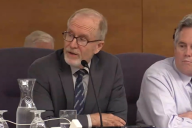You have /5 articles left.
Sign up for a free account or log in.
In a recent conversation with a new president, I was asked, “How do you build a stellar senior team?” The question is a powerful and important one, because only the president can build a great senior team. It is not a delegated task. It takes discipline, time and attention, all in short supply in the life of a president. The question prompted me to think about the many senior teams and cabinets I have worked with over the past 25 years. Only a few stick out as being exceptional; many were smart and hard-working, but few have ever become great.
Everyone on a campus realizes how well the senior team functions. When they are seen as a collaborative, high-performing team, the positive impact is powerful. People throughout the institution work together cooperatively in service of the vision, mission and goals of the organization, because it is modeled by the top leadership. When they function only as individuals, the silos on campus rear their ugly heads, and work across boundaries is difficult and challenging
The following are "practices," not theories, that I have witnessed exceptional teams in higher education live every day. All doable but difficult to carry out. It will take discipline and courage to actually live them, but the payoff is worth it.
1. They live the 65/35 rule.
Stellar senior teams (SST) spend 65 percent of their time and effort on the task at hand. They focus their energy on the results or outcomes they are charged with delivering (e.g., constructing a building; setting up a systemwide technology platform; agreeing to a branding campaign, capital campaign, etc.).
What sets an SST apart from other teams is that its members also spend 35 percent of their time on the "process" side of how they complete their tasks and goals. By the "process" side of things I mean: how team members listen to each other; show respect; give credit and show appreciation for other team member contributions; include others in decision-making; solicit input from team members; provide constructive feedback.
It is the attention to both the task and the process that enables an SST to achieve great things. Unfortunately, most teams spend 90-95 percent of their time on the task side of what they do and very little time on the process side of things. They do so at their peril.
In over 25 years of working with teams, I have never been brought in because a poor-performing team didn't know how to do their tasks well. I have always been brought in because the process side or the relational side has broken down (e.g., when people don't feel heard, feel disrespected, unable to deal with team conflict, not listening to each other.) Leaders need to pay careful attention to the process side because that is what will kill a team's effectiveness and performance.
Regular check-ins are essential. The team leader can't wait for bad news to get to them. If they pay attention to several of the differentiators described in this article (e.g., having team ground rules; no triangulation;) they will improve the process side of their team's functioning.
2. They conduct highly effective meetings.
Many senior leaders spend a great deal of their time in meetings.
Unfortunately, a majority of these meetings are colossal wastes of time. SSTs have powerful, engaging and effective meetings. When you observe one, you experience something very different than most meetings on campus.
Some of the elements of an SST meeting: The purposes of an SST meeting are always clear. Team members know what they are here to do and clearly understand and articulate that different agenda items often have different purposes.
For example: Are we here to make a decision? Solve a problem? Build a sense of community and connection with each other? Resolve a conflict? Share information and get everyone on the same page? Each one of these is a different purpose and has a different intended outcome.
Everyone understands where they are on the agenda, what they are trying to accomplish and what's expected of them. SST meetings tend to be highly interactive and engaging. Members readily participate, share ideas, get involved in the discussion. There is high-energy (not loudness) and focus. It feels different than most meetings people have attended. They tend to have well-organized meetings.
This does not mean linear, tightly managed meetings with tight timelines and a false sense of urgency, for example:
9:00 – Organizational Climate Study, discussion
9:15 – Course Registration Process Review,
9:35 – Upcoming Reward and Recognition Events
9:45 – Customer Satisfaction discussion
10:05 – Branding campaign
They create a reasonable, not overly ambitious agenda, and spend the right amount of time on each agenda item. They always prioritize their agenda and deal with the most important important items first.
They avoid “loose ends” in their meetings. Many meetings run out of time and several agenda items get crushed at the very end of the meeting. People often leave with a feeling of unfinished business and some confusion about who does what. SST meetings create the time at the end of the meeting to review commitments, next steps and accountable actions. Everyone leaves with a clear understanding of their responsibilities and commitments.
What distinguishes SST meetings from others is the following practice: They periodically and anonymously evaluate the effectiveness of their meetings. They realize meetings are important and expensive events in the life of the team and want the investment to pay off.
They ask the following 5 questions:
- On a scale of 1-10 (10 being excellent, 5 average, 1 poor), how effective was our meeting?
- How involved did you feel (1-10) (same criteria as above item?
- What did you like most about our meeting?
- What did you like least and why?
- Advice, comments, suggestions.
The evaluations only take two to three minutes, and can provide a team with excellent information they need to continue to improve their team meetings. The survey also does several other things: conveys that we value your input and time, and communicates that we are continually learning how to be better models that feedback is normal and constructive.
3. They have explicit ground rules.
Every team member has expectations of other team members (e.g., be on time for meetings, don't interrupt each other, come prepared to meetings). Unfortunately, most of the time these expectations are tacit or implicit. People have them but don't voice them, resulting in team members being "disappointed" with each other because of their hidden expectations.
They think to themselves, "It's obvious that people should not interrupt or be on time, etc." but they never make their expectations explicit or known to others.
SSTs make their expectations for each other explicit and negotiate their expectations openly. They identify a handful of team expectations that will best serve the team's purposes and goals. These explicit expectations create human infrastructure for their team to function at a very high level.
They keep the 65/35 rule in mind when creating their team ground rules and agree on three or four (no more than this) working agreements that address both the task and process side of team functioning.
The following are some examples of ground rules exceptional teams have adopted to support their high performance:
- One person talks at a time in our team meetings (this avoids sidebars and interruptions).
- Everyone comes prepared to our team meetings (e.g., if there is any pre-work prior to the meeting -- reports, an article, creating a presentation) everyone is committed to be completely ready for our team meetings.
- Use active listening (where you reflect back what you are hearing) when there is any conflict between team members.
- Periodically, we will anonymously evaluate the effectiveness of our team meetings.
- No back-door politicking when a decision is made, nobody lobbies for a change behind closed doors.
- We expect full participation at our meetings (although stellar teams don't “force” participation but there is a clear expectation that each member will share ideas, provide opinions and participate in discussions).
4. No triangulation.
The term "triangulation" comes from family systems therapy and describes an insidious group dynamic that is a team killer. Triangulation happens when a group member (A) talks about another group member (B) (e.g. complaining, backbiting, about them, ridiculing their ideas) to member (C).
Unfortunately, A never goes directly to B to deal honestly with the issues that divide them. A lot of potential positive energy is wasted between the discussion and gossiping that takes place between A and C. The difficulty between A and B never gets resolved and the backbiting detracts from team effectiveness.
Unfortunately, A never learns how to resolve the issue, C is caught trying to be supportive to A by listening but it is wasted time, and B doesn't even know that the "difficulty" with A exists. All three are trapped in a hidden, vicious cycle that destroys trust between the team members.
The same dynamic is played out in many organizations. Almost every organization has a "rumor mill" that usually spreads negative news, unwarranted rumors and false information. This informal communication system has a lot of power to it and needs constant negativity to fuel the train. In some places, the rumor mill is the trusted source of information for many employees. Obviously, this is bad because the formal communication processes have broken down and this will negatively impact the organization's overall effectiveness.
The way a SST deals with triangulation is singular and powerful. The team simply doesn't allow it. Often, team members have an explicit ground rule that prohibits triangulation (e.g., we don't tolerate triangulation). They expect all team members to go directly to each other if there is a problem.
They also realize there will be conflicts and problems between team members, it is inevitable. If A has a problem with B, A can go to C for advice, feedback, coaching and ideas on how to deal with B effectively. But, you can only seek advice from C once. After that the team expectation is that A will then go directly to B and be honest. A might even ask C to act as a facilitator for the discussion.
This might sound rather simple but it is a game changer. All the human energy goes into positive and constructive actions and efforts and don't get sidetracked with negative stuff. It is a difficult ground rule to adhere to because it really tests people's natural tendencies to complain and gossip about others. It takes integrity and real commitment but it enables SSTs excel.
5. They evaluate the effectiveness of their priority decisions.
Overall, SSTs make very good decisions. They aren't perfect by any means but their track record for making smart decisions is impressive. When they review and reflect on their past decisions, a practice they adhere to, they usually see that the most important decisions they made were pretty good. The intended outcomes and results were produced.
There are some important reasons why they make consistently good decisions:
- They utilize multiple sources of information and actively seek out best practices, see what others have done with similar issues and solicit both quantitative and qualitative data.
- They listen to each other's ideas, opinions and perspective. Because they respect each other, they understand that everyone can make a contribution to the decision-making process.
- They do not defer to the "content experts" on the team. They listen carefully to a team member's expertise but don't give up their responsibility for contributing to the decision-making process. This is a key element – many groups defer to a recognized content expert. It is much easier to do than think through the implications of a particular decision. They solicit the content expert's perspective and advice and openly discuss what they are learning about the content areas and make a decision as a group.
- They don't rush to closure. Too many groups try to be "decisive" and place way too much value on making quick decisions. SSTs do not fall into this trap. They take the time necessary to make an informed decision and they don't get bogged down with a slow decision process.
- Periodically they evaluate the effectiveness of the important decisions they have made over the past quarter or so. They carve out the time to review some of the big decisions they have made and ask some key questions:
- What was our intended result with these key decisions?
- How did we do?
- What went well? What didn't go well?
- Could we have done something differently (e.g., used more information; gotten an external perspective; listened more carefully to different opinions; brought an expert in to inform our decision)?
- What do we need to do/keep in mind in the future when we our make decisions?
This kind of review yields information that can be invaluable to a team's future decision-making. The key is to have the disciple to take the time to review past decisions and the rigor to ask the tough questions about the quality of their decision outcomes.
Becoming a Stellar Senior Team is not for the faint of heart. It takes both aspiration and perspiration, but it is well worth the effort. If senior team adopted just one of these practices, over time, it would make a significant difference in their team's effectiveness. Good luck!








